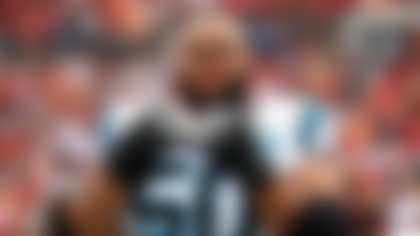Getting to the quarterback is critical to any football team's success -- perhaps second only to the quarterback's ability to throw the ball. There's debate about the most effective way of sacking the signal-caller, but some clues about what works best have been revealed this season.
The top three pass rushers this season are outside linebackers from 3-4 defenses. Dallas' DeMarcus Ware (19), Miami's Joey Porter (17.5) and Pittsburgh's James Harrison (15) have 51.5 sacks between them. The top three pass rushers from 4-3 defenses -- Atlanta's John Abraham (15.5), Minnesota's Jared Allen (14.5) and Carolina's Julius Peppers (12.5) -- all are defensive ends and have 42.5 sacks between them.
So, is the 3-4 defense a better package for rushing the passer? Is the 4-3 defense easier for an offensive line to counter? Those are some of the questions I'll try to answer here.
Base 4-3 defense
In the most popular base 4-3 defense that NFL teams run, the defensive tackle lines up over the strongside guard, meaning all four defensive linemen are situated on offensive linemen who can get a good blocking angle on the pass rushers.
"Big on big is always the preference for an offensive line, and blocking the 4-3 gives you the best chance," said an offensive line coach. Offensive linemen want to block defensive linemen, hence the term "big on big."
Base 3-4 defense
But in the base alignment of a 3-4 defense, a defensive end is in position to prevent the offensive tackle from consistently stepping out and blocking an outside linebacker.
The best pass blocker is usually the left tackle, but if he struggles to clear the defensive end in order to get to the outside linebacker, he'll give up sacks. Porter, Ware, and Harrison all rush from outside and have a defensive end occupying the left tackle in the base look.
3-4 double outside blitz
When 3-4 teams rush both outside linebackers in a double-outside blitz -- especially when the inside linebackers threaten blitz to hold the guards -- at least one gets to rush against a running back, and that's a win for the defense.
Keep in mind that the 3-4 has one less player in a three-point stance than the 4-3 defense, and that might be the key to why the flexible 3-4 has a better chance of succeeding than the 4-3 in the modern game.
4-3 line stunt
One former NFL defensive lineman told me, "Offensive linemen like the 4-3 front because they can get a big hat on a big hat," but if the defense runs a line stunt -- also called "Pirate" -- things can change. In this case, the defensive tackle and defensive end slant across the face of the guard and tackle and penetrate the line of scrimmage as the nose tackle sets for the containment break of the quarterback.
Titans defensive end Kyle Vanden Bosch, a quality player in a 4-3 defense, points out the 3-4's effectiveness: "We have used 3-4 front principles where I'm outside the offensive tackle as well as defensive tackle Albert Haynesworth, and it does cause hesitation from the blockers." Texans offensive tackle Eric Winston backs Vanden Bosch, saying, "The Titans gave us some trouble when they used that 3-4 look to my side with Haynesworth on me and Jevon Kearse outside of me."
3-4 double inside twist
And with four of its seven defenders standing up in a 3-4 look, the defense has the flexibility to send its outside linebackers in different ways.
A double inside twist, in which both outside linebackers blitz between the tackle and guard while the defensive end goes to the outside, is a favorite of 3-4 defenses and an excellent call against a classic pocket passer.
4-3 basic stunt
A 4-3 defense will run its own stunt game in order to free one defender for a shot on the quarterback. It has worked in the past, but offensive linemen now sit on stunt fronts and pick up the twist stunts.
In this 4-3 look, defensive coaches must be careful that the quarterback doesn't break containment.
4-3 double twist
A 4-3 defense's answer to quarterbacks who throw from the midline (5 yards straight back from the center) is called a double twist, but it also has a number of issues.
Will the defensive end get to the passer in time? Will the offensive guards pass the defensive tackles and set for the looping ends?
3-4 linebacker blitz
However, a linebacker blitz shows one of the many ways a 3-4 defense can bring pressure on the quarterback. The inside linebacker eats up the guard, setting an effective outside pressure into motion.
"We practice twice as much against upcoming 3-4 teams than we do against 4-3 teams because of all the pressure combinations they can utilize," an NFL lineman told me recently.
3-4 outside linebacker blitz
Two weeks ago against the Cowboys, the Steelers' creative defensive coordinator, Dick LeBeau, occasionally put both outside linebackers next to each other rather than one on each side in the 3-4. The outside linebacker stepped inside the other linebacker, and it was clear sailing to the quarterback.
The 3-4 defense offers flexibility in looks, features quicker athletes rushing from the outside and forces offensive adjustments that empty the backfield. Not many teams want to be in a 4-3 defense when the opponent has a 3-by-2 empty set with no one in the backfield except the quarterback. However, 3-4 teams are ready for that adjustment with a three-man rush while many four-man fronts have to pop out a lineman into coverage.
The NFL's top two defenses (Pittsburgh and Baltimore) are 3-4 teams. The top two defenses in sacks (Dallas and Pittsburgh) are 3-4 teams. Therefore, it might be time to consider the 3-4 a better package against modern offenses.



